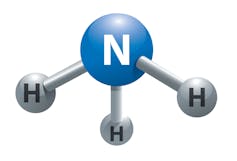Toward sustainable ammonia production

With a growing world population, escalating demand for food and energy and the looming perils of fossil fuel induced climate change, there is an urgent need to make ammonia synthesis more sustainable by using renewable energy sources such as solar or wind-generated electricity. In my lab at the University of Central Florida, we are developing an efficient catalyst to facilitate ammonia production using electricity.

This is an ammonia molecule, one of the most critical ingredients for fertilizers.
By NoPainNoGain/shutterstock.com
Ammonia is currently produced through the Haber-Bosch process, which was developed by German chemists Fritz Haber and Carl Bosch in the early 20th century, and requires high temperature (350−550 °Celsius) and high pressure (2,200−5,100 pounds per square inch) to accelerate the naturally slow reaction. Their contributions to industrial scale ammonia manufacturing processes earned them both Nobel Prizes in chemistry in 1918 and 1931, respectively.
The Haber-Bosch process uses iron to speed up the chemical reaction that combines nitrogen gas from the air with hydrogen to produce ammonia. But scientists are pursuing a more efficient way to facilitate the reaction. We thought that an electrochemical method, which uses electrical energy to convert nitrogen gas and water to ammonia at room temperature, could be a promising approach. But the reaction was incredibly slow – and we needed an efficient catalyst to speed it up.
After reading through chemistry journals, we were inspired by a team at Stanford University who used a rare, silvery metal called palladium to accelerate their electrochemical conversion of carbon dioxide. As far as we could tell, this catalyst had received little attention for the production of ammonia, as it was considered to favor the undesirable production of hydrogen.
Surprisingly, we discovered that palladium catalyst can enable ammonia production quickly and efficiently with minimal electrical input, making it energetically more efficient than previous approaches, as documented in our work published in Nature Communications.
Our computational work suggests that palladium is a great catalyst because it speeds up the chemical reaction in a different way than conventional materials. Basically, palladium is unique in absorbing hydrogen atoms from water and forming an intermediate called palladium hydride, from which hydrogen atoms can hop to nitrogen molecules to produce ammonia. Such a pathway requires less energy than directly adding hydrogen from water to nitrogen molecules.
As a fundamental study and a proof of concept, we demonstrated the approach in a glass cell filled with a water solution at room temperature and then ran an electrical current through carbon electrodes that were loaded with nano-sized palladium particles.
![]() As exciting as this is, it can still be improved, and made even faster. We plan on developing more efficient catalysts that require less palladium – which is pretty expensive. Furthermore, now that we have revealed how palladium catalyses this reaction, we hope to inspire our peers to use this principle to address other fuel synthesis reactions using electricity that can be derived from solar or wind. We believe that research efforts in this field will eventually lead to the development of scalable room-temperature ammonia manufacturing.
As exciting as this is, it can still be improved, and made even faster. We plan on developing more efficient catalysts that require less palladium – which is pretty expensive. Furthermore, now that we have revealed how palladium catalyses this reaction, we hope to inspire our peers to use this principle to address other fuel synthesis reactions using electricity that can be derived from solar or wind. We believe that research efforts in this field will eventually lead to the development of scalable room-temperature ammonia manufacturing.
This article was originally published on The Conversation. Read the original article.
Source: The Conversation Africa

The Conversation Africa is an independent source of news and views from the academic and research community. Its aim is to promote better understanding of current affairs and complex issues, and allow for a better quality of public discourse and conversation.
Go to: https://theconversation.com/africa










